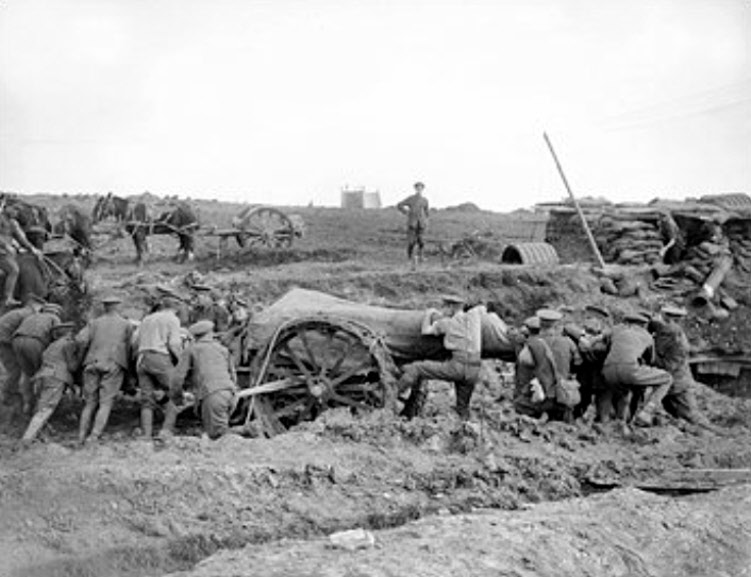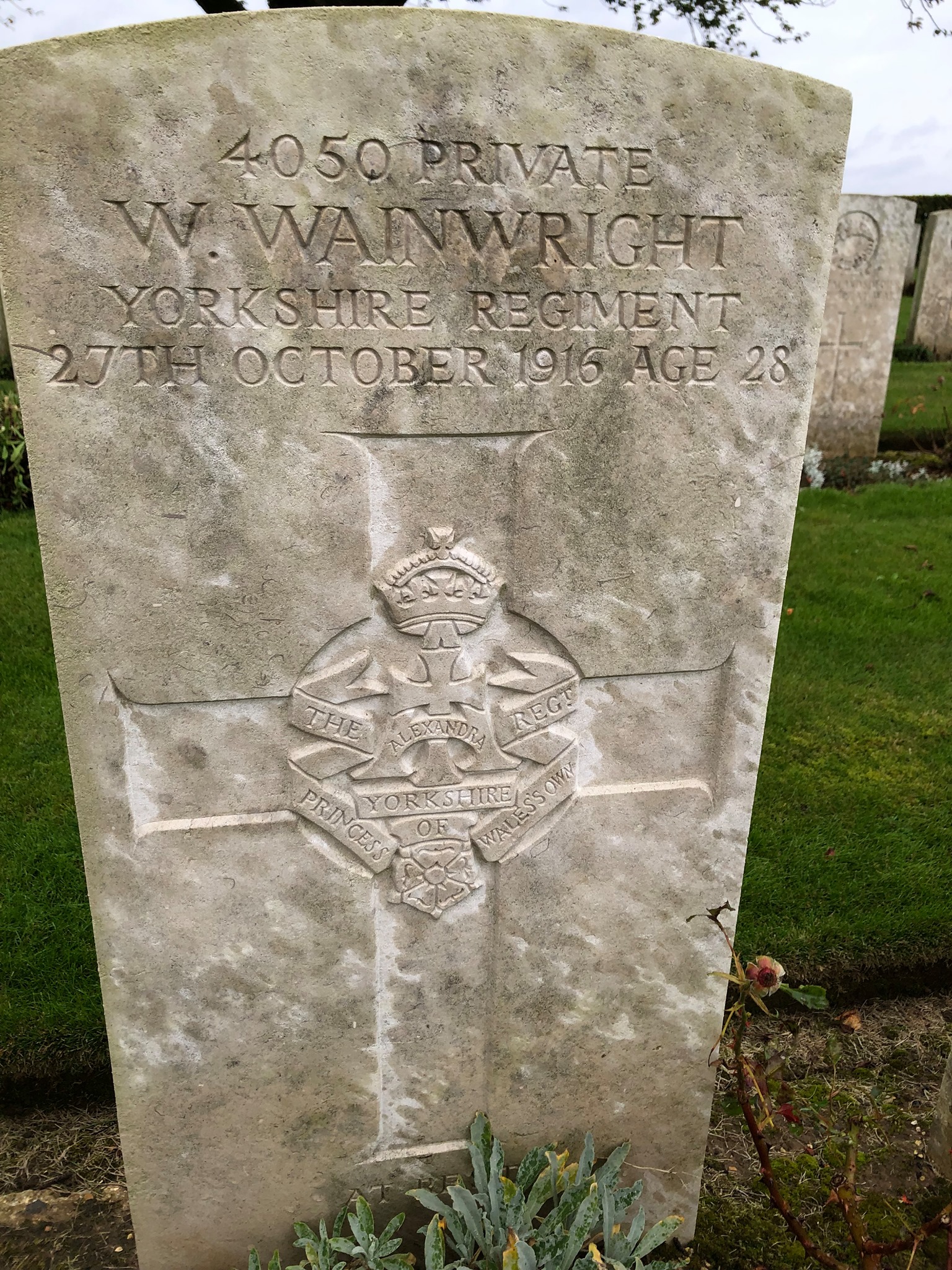
Wilfred Wainwright was born in Ossett in 1888, the son of Walter Wainwright who was a widower by 1901 with three children: Sarah Ann (born 1876), Benjamin (born 1878) and Wilfred, the youngest. At the time of Sarah Ann Wainwright’s marriage to widower Irvine Illingworth in 1898, Walter Wainwright was working as a rag grinder and the family were living in Horbury Road, Ossett.
In 1901, the Wainwright family were still at Horbury Road, Ossett and Wilfred, at the age of 13 years, was working as a farm labourer. By 1911, Wilfred was boarding at the house of Joseph and Emily Gower in Hilda Street, Ossett and at that time was working as a contractor’s labourer.
Wilfred enlisted at Richmond, North Yorkshire with the Yorkshire Regiment (Green Howards) in February 1916. The 1/5th Battalion of the Yorkshire Regiment was formed in August 1914 at Scarborough as part of the York & Durham Brigade, Northumbrian Division and on the 17th of April 1915 they landed at Boulogne. ON the 14th May 1915 the formation became 150th Brigade, 50th (Northumbrian) Division.
The 50th (Northumbrian) Division was heavily involved in the Battle of Le Transloy between the 1st and 18th of October 1916. It is likely that Wilfred Wainwright was killed during the advance, which took place on the 7th October 1916:
“The fighting took place during worsening weather and dreadful battlefield conditions. Fourth Army’s objectives necessitated, as a preliminary, the taking of Eaucourt L’Abbaye and an advance on III Corps entire front was launched, after a seven-hour bombardment, at 3.15pm on 1 October. The attack met fierce German resistance and it was not until the afternoon of 3 October that the objectives were secured. Rawlinson’s follow-up attack was delayed by atrocious weather. Starting at 1.45pm on 7 October the advance involved six divisions and resulted in heavy British casualties and little success except for 23rd Division’s capture of Le Sars. Continuous rain during the night hampered the removal of casualties and further forward moves. The failure to secure original battle objectives led to a renewed major assault on the afternoon of 12 October when infantry on Fourth Army’s right floundered towards German trench lines in front of Le Transloy, while formations on the left slogged towards the Butte de Warlencourt. Despite the slightest of gains (measured in hard fought for trench yards) the operation was not successful. Orders for a fresh attack, issued late on 13 October, ignored the desperate conditions and physical state of the attacking troops. The subsequent early morning assault on 18 October (well before daylight) witnessed heroic efforts to advance but minimal gains were made against resolute defenders well supported by accurate artillery fire.” 1
The “Ossett Observer” 2 had this obituary for Private Wilfred Wainwright:
“The sad news came to hand on Thursday morning that Private Wilfred Wainwright (29) of the 5th Yorkshire Regiment (Green Howards) had lost his life in the war. A well-known and respected South Ossett young man, the deceased was formerly employed as a plasterer by Messrs. Sanderson and Son, with whom he served his apprenticeship, and for the past few years he has resided with his sister and brother-in-law, Mr. and Mrs. Irvine Illingworth, of Manor-road. A member of the South Ossett Church Institute, he was an enthusiastic member of the cricket club.
It was in early February that he joined the colours as a Derby recruit, and he proceeded to the western front towards the end of July. On Thursday morning Mrs. Illingworth received a letter from an officer, saying: ‘It is with great regret that I have to inform you of the death of your brother, Private Wilfred Wainwright. He was killed by a shell on the 30th of October (n.b. this date is incorrect). It will be a great consolation to you to know that he died instantaneously and suffered no pain whatever. He was a very good soldier, and very popular with both his comrades and officers. Please accept my sincere and deep sympathy in your great loss.”
Private Wilfred Wainwright died on the 7th October 1916, aged 28, the brother of Benjamin Wainwright, 65 Springstone Avenue, Ossett, Yorkshire.

Above: British soldiers moving artillery at Transloy Ridges in October 1916.
Private Wilfred Wainwright is buried at grave reference VIII. F. 14 at the Caterpillar Valley Cemetery, Longueval 3, Somme, France. Longueval is a village approximately 13 kilometres east of Albert and 10 kilometres south of Bapaume.
Caterpillar Valley was the name given by the army to the long valley which rises eastwards, past “Caterpillar Wood”, to the high ground at Guillemont. The ground was captured, after very fierce fighting, in the latter part of July 1916. It was lost in the German advance of March 1918 and recovered by the 38th (Welsh) Division on 28 August 1918, when a little cemetery was made (now Plot 1 of this cemetery) containing 25 graves of the 38th Division and the 6th Dragoon Guards. After the Armistice, this cemetery was hugely increased when the graves of more than 5,500 officers and men were brought in from other small cemeteries, and the battlefields of the Somme. The great majority of these soldiers died in the autumn of 1916 and almost all the rest in August or September 1918.

Commonwealth War Graves Commission Headstone (Photograph courtesy of Mark Smith)
References:
1. The Twelve Battles of the Somme (1st July – 18th November 1916)
2. “Ossett Observer”, 12th November 1916